In the final leg of campaigning for the 16th General Election to be held from April 7-May 12, the issue of education provision and reform is conspicuously missing from the public discourse
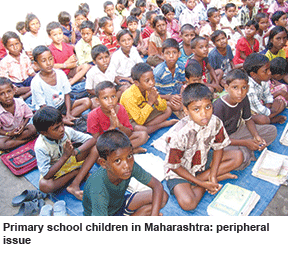
UNSURPRISINGLY AND IN keeping with post-independence India’s myopic political tradition, education of the world’s largest child and youth population — 600 million Indians are below 24 years of age — is a low-priority and hardly noticeable item for political parties donning battle gear for General Election 2014. In the final leg of campaigning for the country’s 16th general election to be held from April 7-May 12, the issue of education provision and reform is conspicuously missing from the public discourse.
At election rallies, public meetings, in the print media, television and on the internet, leaders of the country’s major and minor political parties wax eloquent on the 2002 Gujarat and 1984 anti-Sikh riots, corruption, inflation, secularism, communalism, etc. But below-the-line issues of larger budgets for public education, upgrading the crumbling infrastructure of government schools, improving teacher-pupil ratios, contemporising curriculums, stemming the 53 percent dropouts from primary education and improving rock-bottom learning outcomes, are peripheral and will undoubtedly merit no more than mention in the manifestos of all political parties which are yet to be released as this issue of EducationWorld goes to press.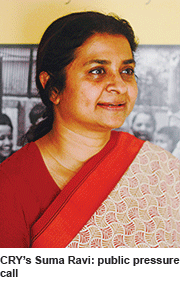
Though political indifference to education and child welfare is not new, it’s particularly glaring in the run-up to Election 2014 because over the past decade, there’s been rising public awareness about the critical importance of elementary education and sustained pressure from civil society groups to push children’s rights to the forefront of the national development debate. For instance, last November Child Rights and You (CRY), the well-known Mumbai-based NGO, launched a six-month campaign titled ‘Vote for Child Rights’ and released its Child Rights Manifesto, urging political parties to commit to putting children at the centre of all policy, legislation and practice.
“Despite children constituting over a third of India’s population, issues relating to their care, safety, protection, health and education are ignored by the political class. That’s the reason why CRY decided to launch its ‘Vote for Child Rights’ campaign to pressurise political parties to put children first, and commit to implementing our Child Rights Manifesto. In the past five months since we launched the campaign we have received over 1.4 million online votes, and have met leaders of all major political parties to persuade them to do more for children and guarantee their rights to education, protection and healthcare. Even though all political parties expressed their support for our manifesto, it remains to be seen whether they actually accept our demands. The only way to get the political class to act is by building the pressure of public opinion in favour of children and education,” says Suma Ravi, regional director (South) of CRY.
The Child Rights Manifesto, based on CRY’s Status and Trends in Child Rights in India — An Overview of the Past Decade report, makes 10 demands including effective implementation of the Right of Children to Free and Compulsory Education (aka RTE) Act, 2009, strengthening the Integrated Child Development Services (ICDS) programme and larger budgetary allocations for education and children. (see box p.78).
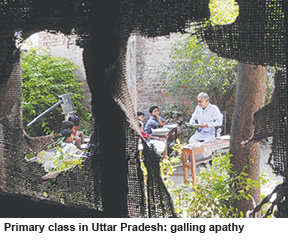 Likewise, at a convention held in the national capital on March 13 and attended by representatives from 18 states, the RTE (Right to Education) Forum, a national coalition of over 10,000 NGOs, educationists and social activists, demanded that education be made a leading issue in the upcoming elections. “Education is the most peripheral sector for political parties. The sorry implementation of the RTE Act, 2009 is just one indication of how the government has failed India’s public and children. We urge the people of this country to question candidates on how they plan to promote quality education in their constituencies. The run-up to the polls is the perfect time to make politicians accountable and take them to task for unfulfilled promises. Education needs to be given high priority in all party manifestos. The issues of bijli-sadak-pani (electricity-road-water) are not the only demand of the people. Education should be high on the agenda of all political parties,” says Ambarish Rai, Delhi-based convenor of the RTE Forum.
Likewise, at a convention held in the national capital on March 13 and attended by representatives from 18 states, the RTE (Right to Education) Forum, a national coalition of over 10,000 NGOs, educationists and social activists, demanded that education be made a leading issue in the upcoming elections. “Education is the most peripheral sector for political parties. The sorry implementation of the RTE Act, 2009 is just one indication of how the government has failed India’s public and children. We urge the people of this country to question candidates on how they plan to promote quality education in their constituencies. The run-up to the polls is the perfect time to make politicians accountable and take them to task for unfulfilled promises. Education needs to be given high priority in all party manifestos. The issues of bijli-sadak-pani (electricity-road-water) are not the only demand of the people. Education should be high on the agenda of all political parties,” says Ambarish Rai, Delhi-based convenor of the RTE Forum.
The conspicuous absence of education in election debates in India is in sharp contrast to the West where education is invariably a core election issue. In the US, education reform — from early childhood to university education — was a central campaign issue of Barack Obama in the 2009 and 2012 presidential elections. Similarly in the UK, former prime minister Tony Blair in his re-election campaign of 2001, famously proclaimed his top three priorities were “education, education, education”.
The apathy of post-independence India’s political leaders and the establishment to placing education right at the top of the national development agenda is particularly galling given that the country’s early childhood, primary, secondary and higher education systems are in perilous condition. Early childhood care and education (ECCE) is an area of darkness with the country’s 1.35 million anganwadis — child nutrition and maternal care centres promoted under the Central government’s ICDS programme — offering basic nutrition and maternal care with minimal emphasis on preschool education. Moreover, only 75 million of the country’s 158 million children under age five are accommodated in anganwadis, for which a provision of Rs.17,700 crore — Rs.2,360 per capita per annum — was made in the Union Budget 2013-14. Little wonder the Starting Well index of the Intelligence Unit of The Economist which surveyed ECCE systems of 45 countries, ranks India last, behind Ghana and the Philippines.
THE CONDITION OF THE country’s 1.30 million primary schools is no better. Four years after the RTE Act, 2009 made it mandatory for the State to provide free and compulsory education to every child aged 6-14 years, 92 percent of primary schools are non-compliant with the infrastructure and teacher-pupil ratio norms of the Act, an estimated 11.9 million children aged 6-14 are out of primary school and there’s a shortage of 700,000 teachers countrywide.
According to the Union human resource development ministry’s RTE: The 3rd Year report, of the country’s 1.1 million government and aided schools, 31 percent (300,000) still don’t provide separate toilet facilities for girl children, 44 percent are without disability ramps, 39 percent don’t have boundary walls, and 40 percent lack kitchen sheds to prepare the government provided free mid-day meals. Moreover, only 37 percent of the country’s primary schools meet the prescribed teacher-pupil ratio of 1:30, and 9 percent (over 90,000) make do with a single teacher. Add to this, inadequately qualified and trained primary teachers — pass percentages in the Teacher Eligibility Tests (TETs) range between 0.3 to 6 percent countrywide.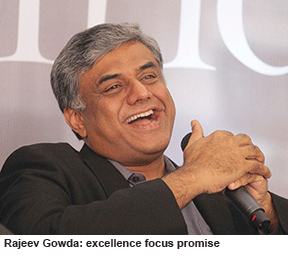
Shoddy infrastructure and teachers apart, there’s a steady downtrend in the learning outcomes of primary school children nationwide. According to the Annual Status of Education Report (ASER) 2013, published by the highly-respected education NGO Pratham, which assesses the reading and numeracy skills of students enrolled in primary schools in the rural hinterland of India, the percentage of class V children who can read class II textbooks has decreased from an already dismal 52.8 percent in 2009 to a worse 46.9 percent in 2013. Likewise, the percentage of class V children who can solve simple three-digits by one-digit division sums (which they should have learned in class III) has inched up to a deplorable 25.16 percent.
Little wonder that of the 220 million children enrolled in elementary schools at the start of every academic year, more than half drop out before class VIII with the result that only 55 million are enrolled in secondary education (class IX-XII). India hosts a mere 135,000 secondary (classes IX-X) and 76,000 higher secondary (classes XI-XII) schools (cf. 1.3 million primaries). Despite this, the Rashtriya Madhyamik Shiksha Abhiyan (RMSA) — a Central government-sponsored scheme launched in 2009 “to universalise access to and improve quality of secondary education” — has completed the construction of a mere 9,219 additional secondary schools and 9,516 additional classrooms countrywide, and appointment of 21,936 teachers during the past five years.
Weak fundamentals and poor learning outcomes in school education have forced down standards and quality in higher education. Although only 19 percent of youth in the 18-24 age group is enroled in higher education (cf. 80 percent in the US, 28 percent in China), India’s 700 universities and 35,000 colleges, which enroll an estimated 20 million students, are beset with funding constraints, faculty shortages, rock-bottom tuition fees, and over-regulation. Consequently none of India’s higher ed institutions are ranked in the league tables of the world’s Top 200 universities published annually by the London-based Quacquarelli Symonds Ltd (QS), a global research and consultancy company, and Times Higher Education weekly.
Though it’s patently clear the severe under-funding and neglect of education by successive governments at the Centre and in the states has resulted in this sorry state of affairs, the Congress, which has ruled in Delhi for 49 of the 67 years since independence, denies that the party high command has ignored education dissemination and reform. On the contrary, Rajeev Gowda, the Bangalore-based national spokesperson of the Congress, believes the party has expanded access to education during the past six decades.
“Education is a top priority of the Congress party. When we won India’s independence, only 17 percent of the population was literate and we had 26 universities and 400,000 students in higher education. Since then, literacy has risen from 17 to 74 percent, the number of universities to 700 and number of colleges from 690 to 35,000, and today 20 million students are in higher education. Moreover, we have steadily enacted legislation to make education accessible to all. The RTE Act, 2009 is our initiative and will surely transform the country. Perhaps not enough attention was paid to the quality of education dispensed in our institutions. Therefore in the coming years, the focus will be on excellence,” says Gowda, an alumnus of Fordham University and the Wharton School (USA), and currently professor of economics and social sciences at IIM-Bangalore.
THE FLAW IN Gowda’s argument is that he conveniently measures the country’s education attainments from a low base, ignoring the reality that almost all Asian countries — China, South Korea, Singapore, Indonesia etc which were more illiterate and educationally under-served six decades ago — have surpassed India on the indices of literacy and other metrics. Even in its latest two-term tenure (2004-2014) in Delhi, the Congress party which spent most of its time fire-fighting a spate of corruption scandals, couldn’t get 20 pending education Bills — 11 relating to higher and nine to primary-secondary education — passed in Parliament. The Congress-led UPA-II government’s sole education achievement is the RTE Act, 2009 which has passed on a part of the obligation of providing primary education to private schools. But on the vital issue of larger outlays for education — 6 percent of GDP as recommended by the Kothari Commission in 1966 and repeatedly promised by the Congress party — there’s been no progress. During the past decade, government (Centre plus states) expenditure on education averaged 3.3 percent of GDP.
.gif)
With all opinion polls predicting a rout of the Congress party in the imminent general election, the education agenda of the Bharatiya Janata Party (BJP), led by three-time Gujarat chief minister and prime ministerial candidate Narendra Modi, merits close attention. Though the party’s 2014 manifesto is yet to be released, according to its spokespersons education will be given top billing in the BJP manifesto. The party has proposed a Rs.600,000 crore ‘Indian education megaproject’ under which 30,000 new secondary schools will be built countrywide within the next five years. Under the project, 1.74 million teachers will be appointed, some laterally from other professions by offering them excellent housing/healthcare facilities. Funding for this massive project will be raised through innovative financing including divestiture of public sector companies, and through greater private sector participation.
Moreover the BJP Election 2014 think tank has devised a 15-year master plan for education. “Huge financial flexibility can be achieved by shifting to a 15-Year master plan for education in India, which will make lakhs of crores available for education and healthcare. China has formulated such a 15-year Investment Plan for Science & Technology. Because of UPA-II government’s inaction over the past ten years, over 150 million young people will enter the jobs market by 2016-18 in an environment where no major industrial projects are taking off. If sufficient jobs are not created in time, there will be very serious social problems. For a country of 1.23 billion people, it is foolish to continue with Nehru’s five-year plans — especially in education and healthcare as the funds required can never be made available in the five-year planning horizon. We intend to move to a 15-year master plan for education,” says Meenakshi Lekhi, national spokesperson of the BJP, who however side-stepped the question whether a BJP-led government will increase the annual education outlay to 6 percent of GDP.
.gif) Yet while the two national parties readily shared their plans for education with EducationWorld correspondents, the newly launched Aam Aadmi Party, which has been catapulted to national political prominence within less than a year of its founding, refused to disclose its education agenda. “Our manifesto is almost ready and we will be launching it soon. We cannot share it (education policies) before we officially launch the manifesto,” wrote AAP volunteer Bipul Dey in an e-mail response to EW.
Yet while the two national parties readily shared their plans for education with EducationWorld correspondents, the newly launched Aam Aadmi Party, which has been catapulted to national political prominence within less than a year of its founding, refused to disclose its education agenda. “Our manifesto is almost ready and we will be launching it soon. We cannot share it (education policies) before we officially launch the manifesto,” wrote AAP volunteer Bipul Dey in an e-mail response to EW.
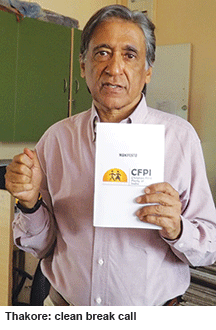 Ditto the Trinamool Congress (TMC) party, which could well emerge as king-maker in Delhi if none of the national political parties wins a majority. A barrage of telephone calls and e-mails to TMC leaders elicited no response. “We are very tied up with preparations for the 2014 Lok Sabha elections… and are presently talking only to the mainstream media,” a party spokesperson informed EW’s Kolkata correspondent Baishali Mukherjee. Evidently for TMC, which ended 34 years of uninterrupted rule of the CPI-M in West Bengal in 2011, but has since been heavily criticised for its failure to usher in the promised poriborton (change), neither EducationWorld nor education is ‘mainstream’ and worthy of special attention.
Ditto the Trinamool Congress (TMC) party, which could well emerge as king-maker in Delhi if none of the national political parties wins a majority. A barrage of telephone calls and e-mails to TMC leaders elicited no response. “We are very tied up with preparations for the 2014 Lok Sabha elections… and are presently talking only to the mainstream media,” a party spokesperson informed EW’s Kolkata correspondent Baishali Mukherjee. Evidently for TMC, which ended 34 years of uninterrupted rule of the CPI-M in West Bengal in 2011, but has since been heavily criticised for its failure to usher in the promised poriborton (change), neither EducationWorld nor education is ‘mainstream’ and worthy of special attention.
“TMC’s attitude is hardly surprising. During elections, political parties have always given education lowest priority. In a country where a large section of the population is still not able to access basic education, it’s alarming this sector gets such little attention. People have a right to know of the plans of political parties to improve the country’s school and higher education systems, teacher training and skills development, and the budgets they will allot to education initiatives. As far as I’m aware, only the CPM (Communist Party of India-Marxist) is committed to increasing annual spending on education to 6 percent of GDP. Sadly, education issues are not discussed and debated by political parties during elections. It’s a dangerous situation and can jeopardise the country’s future,” says Sudin Chattopadhyay, the Kolkata-based former president of the West Bengal Board of Higher Education.
AN EXCEPTION IN THE Indian political milieu is the newly registered (August 2013) Children First Party of India (CFPI) whose prime objective is to transform India into a child and youth centric society. Promoted by our very own Dilip Thakore, publisher/editor of EducationWorld, in its manifesto released in Bangalore, Mumbai and Delhi but studiously ignored by the media, CFPI promises to “immediately” raise the annual expenditure on education to 6 percent of GDP and implement a revolutionary lib-lab-lav plan to equip all 1.3 million government primary-secondaries countrywide with libraries, laboratories and lavatories within 365 days with a capital expenditure of Rs.42,751 crore to be funded by the sale of public sector enterprises.
 “Although contemporary India has the world’s largest national child population of 480 million and the number of children and youth (below 25 years of age) aggregates 600 million, this is the most neglected segment of the population. With all the major political parties oblivious to the gradual erosion of India’s human capital and impervious to all calls to revamp the nation’s crumbling education system, the time has come to make a clean break with the self-destructive politics of the past 66 years. This is the rationale behind the promotion of Children First Party of India. Yet while saving Generation Next through a major education reform, improvement and upgradation programme is the top priority on the national development agenda of CFPI, this is a fully-fledged political party with a well thought-out programme across all sectors of the Indian economy. Unfortunately, CFPI isn’t contesting the 2014 election, but will be ready for the next one,” says Thakore, as yet a voice in the wilderness of Indian politics.
“Although contemporary India has the world’s largest national child population of 480 million and the number of children and youth (below 25 years of age) aggregates 600 million, this is the most neglected segment of the population. With all the major political parties oblivious to the gradual erosion of India’s human capital and impervious to all calls to revamp the nation’s crumbling education system, the time has come to make a clean break with the self-destructive politics of the past 66 years. This is the rationale behind the promotion of Children First Party of India. Yet while saving Generation Next through a major education reform, improvement and upgradation programme is the top priority on the national development agenda of CFPI, this is a fully-fledged political party with a well thought-out programme across all sectors of the Indian economy. Unfortunately, CFPI isn’t contesting the 2014 election, but will be ready for the next one,” says Thakore, as yet a voice in the wilderness of Indian politics.
As this issue of EducationWorld goes to press, the election manifestos of most political parties are yet to be released to the public. But the general expectation is that they will make passing reference and ritual promises related to education upgradation and reform with no financial commitments. Moreover, India’s cynical political class is well aware that election manifestos are expressions of intent and can be ignored after elections are over. Comments Prof. (Dr.) Ranbir Singh, vice chancellor of the National Law University, Delhi: “We are a nation of lost priorities and education has never been an important priority for the country. The promises political parties make in their manifestos hardly matter as they are a few pages printed for elections. Most manifesto promises are populist slogans. After they win the elections, they forget about redeeming their pledges.”
ACCORDING TO Dr. Krishna Kumar, former chairman of NCERT and professor of education at Delhi University, there is an explanation for the curious apathy of Indian politicians towards education. “No matter how categorically a party or candidate might comment on them, the problems of education cannot compete with those of water and electricity supply or the condition of roads. These latter problems affect the daily life of citizens more elementally than education does. The effects of educational policies — good or bad — take decades to manifest. Political leaders and administrators, like media producers, chase a daily or, at best, a weekly schedule. Even the Planning Commission has been lured by the clarity of short-term prospects. The fact that education matters only in the long run makes it singularly uninteresting for seasoned political parties. No one in politics likes to be called an idealist — the label given to someone who talks about distant implications. No wonder, therefore, that education does not count as a serious election issue,” writes Kumar (The Hindu, March 24).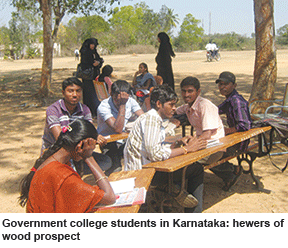
Yet the fact that there’s continuous and building pressure from civil society (CRY, RTE Forum), educationists (Krishna Kumar) and the media (EducationWorld) on political parties to cut the world’s largest national child population a fair deal, is making it difficult for political leaders to fudge the clamorous education debate. There’s rising awareness nationwide that India’s primary, secondary and higher education systems need to be overhauled, and the lack of vocational education and training, is an issue with critical long-term implications for the country’s favourable demography. Despite a global consensus that development of human capital is the precondition for moving to a higher growth trajectory, India’s major political parties including the Congress and BJP, seem indifferent to the urgent necessity of overhauling the education system.
Therefore, the onus of saving generation next from the ignominy of having to serve as hewers of wood and drawers of water in the rapidly crystallising global economy has devolved upon the citizenry and youth. They need to step up the pressure to force political parties to move education to the top of the national development agenda. Or alternatively, vote parties committed to the welfare of children and youth to power.
With Garima Upadhyay (Delhi) & Baishali Mukherjee (Kolkata)